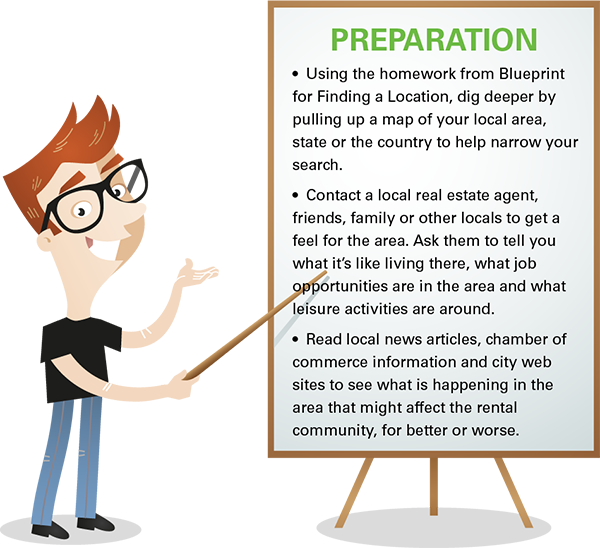10 Tips to Select a Location

When you’re in the market for an investment property finding the right location is crucial to ensure it meets your goals. Whether it’s long-term capital growth, cash-on-cash return or immediate value creation, we’ve rounded up some advice to help you identify the best possible location.
1. Know Your Goals

For most investors your goals and investment roadmap dictates in which areas you should be looking. Go to Education Center > Plan > Real Estate Investment Strategies and refer to Route Guidelines in the Investor Strategy Roadmap. Knowing your goals, ability to finance and market conditions is a must before you begin your search. Are your goals:
- Like Matt with a retirement gap looking for the highest cap rate anywhere?
- Similar to Sara looking for a low-risk condo in a specific location?
- The same as Jennifer and Jim looking for a multi-family with high cash flow goals?
- To be a wholesaler like John who is searching for his first deal?
2. Find a Favorable Rent-to-Purchase Ratio
3. Follow Redevelopment Infrastructure Spending
4. Seek Out Big Companies and Colleges
5. Look for Stable Employment or Job Growth
6. Try to Find the Opportunity Neighborhoods
7. Discover Lifestyle Attractions
8. Find Reasonable Vacancy Rates
9. Find Lower Levels of Crime
10. Hang Out with Some Locals
This is a strong driver to see if a location can provide a decent return without delving into all the expense-related data for specific properties. The industry benchmark is Gross Rent Multiplier (GRM) and it is defined as the ratio of the price of a real estate investment to its annual rental income (before expenses such as property taxes, insurance, maintenance, etc.). It defines the number of years the property would take to pay for itself in gross received rent. For the investor a lower GRM (perhaps under 15) is better than a higher GRM (perhaps over 20), which is a poor opportunity.
Getting the GRM for Recent Property Sales
Calculation: Market Value / Annual Gross Income = Gross Rent Multiplier
Example: Property sold for $250,000 / $20,000 Annual Income = GRM of 12.5
The GRM is useful for comparing and selecting investment locations and properties where your expenses can be expected to be uniform across both areas (because there are no expenses considered like property tax or insurance). Don't get too reliant on this calculation, but it’s valuable to help narrow down a list of potential locations.
Infrastructure and redevelopment typically drives property prices. Many experienced investors follow infrastructure trends. You should look at where the government and private industry is upgrading infrastructure, as it is a strong sign of an up-and-coming neighborhood. Infrastructure typically involves the technical structures that support a community, such as roads, bridges, water supply, energy production, industry redevelopment, sewers, electrical grids, and telecommunications. All of these are essential to enable, sustain, or enhance economic and resident living conditions.
HINT: Examples include: Cleveland, Indianapolis and Buffalo
Cleveland, Ohio began revitalizing its downtown in the mid-1990s. The Greater Cleveland Partnership estimates about $7 billion is being spent on major real estate, corporate and business-development efforts in Cleveland and its suburbs. Today, more than $3.5 billion is currently invested in furthering the area's redevelopment.
Indianapolis, Indiana has invested nearly $9 billion of public and private funds since 1990 at an average of more than $408 million each year and continues with $3 billion of new construction and renovation efforts to be completed by 2017.
Buffalo, New York has pledged $1 billion in New York State funds to attracting complementary private investment at a 5:1 leverage ratio creating a hub for clean energy research and manufacturing, as well as a center for medical genomics research centered around the University at Buffalo’s supercomputing capabilities.
Many investors choose to buy where there is long term or temporary activity that requires people to relocate. For example, young people attending college and contract workers prefer to rent because it makes no sense to buy for the short-term. Also finding big service industries like healthcare, education, finance, and insurance employers provides a solid foundation for real estate investments. These areas can make great rental markets; however, look out for high purchase prices.
HINT: You don’t have to be across the street from the employer; selecting a location with good transportation works, too. I’ve purchased a rental property on a direct and frequent bus route to the local clinic and hospital. I bought 10 minutes away and got a better price than properties on the hospital’s doorstep and still attracted medical staff as long-term tenants.
To be a successful investor and landlord you need renters who have a steady income stream and can afford the rent. You can compare local unemployment rates against the national unemployment rate at www.census.gov. Don’t be too brash in making a decision based on this statistic alone because many other factors will drive the demand for your investment (size, condition, local facilities, proximity to employers, etc.).
HINT: Right now I try to invest in regions with unemployment below 8% and then focus on other criteria to hone my decision.
Most neighborhoods have those preferred pockets. To best understand the location you’re exploring, take a map down to the local real estate agent’s office and ask them to map out with a highlighter the different “pockets” in order of popularity and callout the ones with potential. If you are a remote investor you can have the same discussion with a real estate agent or turnkey provider over the phone or web meeting. Transitional neighborhoods offer great options for investors. If you can find a combination of redevelopment, solid employment, and undervalued properties it’s a powerful recipe for growth.
Hint: I identified for example the communities on the boundary of University Circle located on the east side of Cleveland, Ohio. It had a center of world-class cultural, educational and medical institutions, including Case Western Reserve University and Cleveland Institute of Music and Art. There were and still are many run-down blocks with foreclosures surrounding this area ripe for investment.
Buyers and renters favor areas with lifestyle attractions. Young renters, families and retirees place different value on access to parks, beaches, woodlands and recreational opportunities.
Vacancy rate is an important factor, but not the most important consideration for investors. It is often linked to the economic and market conditions at that time. The national rate varies but currently sits between 7% and 8% for rental properties and can be found at www.census.gov. Note your vacancy rate will depend upon a number of criteria including property type and condition, and the performance of your property manager amongst others. Take the vacancy rate for your location and factor it into your return on investment.
Hint: It can be economically better to own in a neighborhood with a higher-than-average vacancy rate but with a low GRM. I personally try to target locations with less than 8% for single family homes and assume higher for multi family.
Crime is an important factor in selecting a location. Many high cash-flow locations have lower-value properties with decent rents where the GRM is great, but the tradeoff is higher-than-average crime rates. What you need to understand is that there are good and bad blocks and streets and moments in time. Crime can spike when foreclosure rates rise and it can be a great time to swoop in and pick up undervalued properties. However, you have to time the recovery and be prepared to own during some tough times.
Use the other criteria first and select a region you like because of favorable rent-to-purchase prices, employment rates and redevelopment projects and local facilities. Then layer in crime rates and try to find the right blocks within this neighborhood by looking at www.citydata.com and local statistics. Walk the area to locate the good streets in these neighborhoods or have your bird dog or turnkey provider still do it. When you walk around tell people you're looking at the area, and ask everyone on the street: How is the street? Have you been there for a while? Are there any crazy spots nearby? Is it getting better or worse?
Hint: I had a local rehab team walk the streets in Indianapolis in an area getting redevelopment attention. They documented with photos and email how many homes were rehabbed, how many were under rehab and how many still boarded up. I used city data and other sites to supplement my research. Looking at the data there were 12 houses remodeled in the last 18 months, and six had contractors visibly working on them. Only eight houses left on the block were unoccupied. They were easy to spot as the grass in the yard was knee-high the house's paint was peeling away like old wallpaper. I picked up three of them and in just over a year there were no more vacant and scary looking homes in a 2-block radius. I installed alarm systems and security lighting, and have seen sales prices significantly rise and wish I had bought more.
When investigating a new area always ask your real estate agent why people like living here. Then, pop down to the most popular spots, whether that’s a local family picnic area or cafe and observe the type of atmosphere and people who are there.
Hint: I bought a four-unit apartment building out of state where I worked with the local selling agent. Before I made an offer and ultimately a site visit I looked up the property on Google and found a local 7-11, restaurant and sports bar. I picked times of day when I thought they would be quiet and called to chat to the staff claiming to be relocating to rent across the street. I got a great feel for the area this way.
Passive Investing in the Best Locations

Not in My Backyard
Sometimes the will of becoming a real estate investor just isn’t enough. This is common in less populated areas where there simply aren’t enough units available to sustain a real estate investment enterprise. Or, economically, the local economy takes a hit and property values fall while vacancy rates rise. Again, that leaves you with few, if any, choices. However, the passive investor can take advantage in other parts of the state or country where real estate markets are strong and getting stronger.
Investing in areas that are on the rise makes sense instead of trying to make a purse out of a sow’s ear so to speak. Real estate investing is math and you can’t force the numbers to work—they either do or they don’t and if you have to guess you probably guessed on the wrong side.
The passive investor isn’t restrained by geography, which means an unlimited opportunity to select where to invest and that creates more wealth potential. Yes, buying local has some major advantages but if the market isn’t right and you still want to invest, go elsewhere. Refer to the Buying Out of State lesson for some more tips here.
Using a fishing analogy—Go fishing where the fish are biting, and not in an empty pond.
SUMMARY
- Rely on your goals and strategy as your starting point to selecting a location
- Try to be consistent but not rigid with your selection criteria
- Passive investors can invest beyond their local area where markets are favorable

